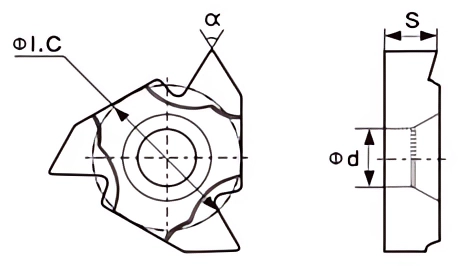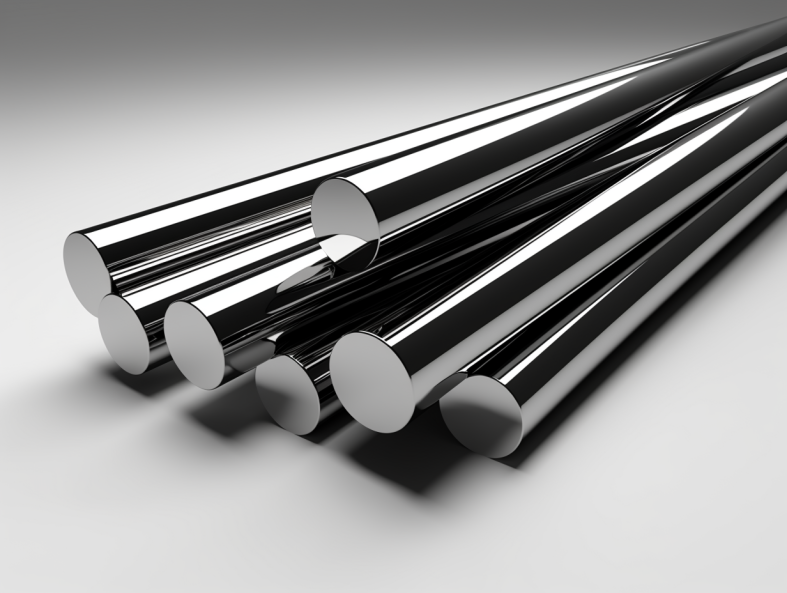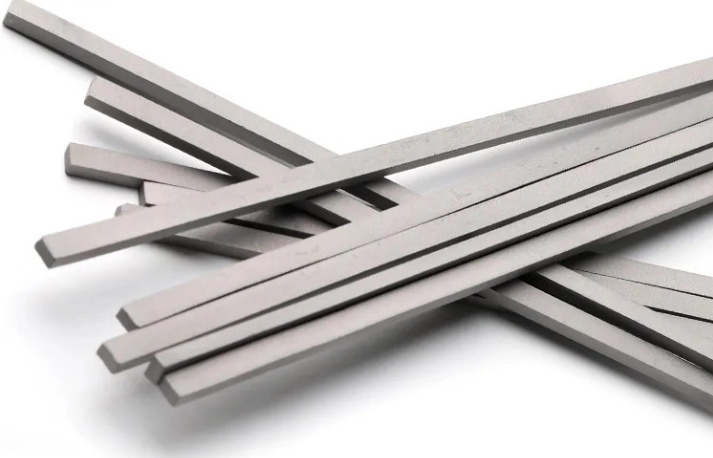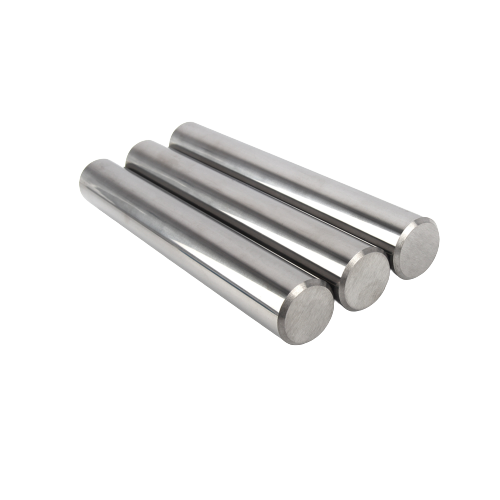Introduction: Where Precision Engineering Meets Threaded Connections
In the intricate world of machining, few tasks demand the level of precision and control as creating threads. These helical grooves, essential for secure fastenings and precise movements in countless applications, rely on specialized cutting tools known as threading inserts for turning. This comprehensive guide delves into the fascinating realm of threading inserts, unraveling their complexities, exploring their diverse applications, and empowering machinists with the knowledge to achieve threading excellence.
Threading Inserts Demystified: The Cornerstone of Precision Threading
What are Threading Inserts?
Threading inserts for turning are indexable cutting tools specifically engineered to machine external and internal threads on lathes or turning centers. Unlike their counterparts used for general turning operations, threading inserts feature precisely ground cutting edges that correspond to the desired thread form, pitch, and diameter. This specialized geometry allows for the efficient and accurate creation of threads in a single pass or multiple passes, depending on the thread specifications and material being machined.

The Mechanics of Thread Creation:
The magic of threading inserts lies in their ability to precisely remove material along a helical path, gradually forming the desired thread profile. As the insert rotates with the spindle, its cutting edge engages the workpiece, shearing away material in controlled increments. The feed rate of the tool, synchronized with the spindle speed, determines the thread’s pitch, while the depth of cut governs the thread’s depth and ultimately its major diameter.
Manufacturing Process: From Raw Material to Precision Tool:
The journey of a threading insert from raw material to a precision cutting tool is a testament to advanced manufacturing techniques:
- Powder Metallurgy: Most threading inserts start their life as a blend of fine carbide powders, typically tungsten carbide, along with binders and other additives that enhance specific properties.
- Pressing and Shaping: The powder mixture is then subjected to immense pressure in a mold, forming the basic shape of the insert, including its cutting edges and chipbreaker geometry.
- Sintering: The pressed inserts undergo a high-temperature sintering process in a controlled atmosphere. This critical step fuses the carbide particles, increasing the insert’s hardness, strength, and wear resistance.
- Coating (Optional): To further enhance performance, many threading inserts receive a thin, incredibly hard coating, such as Titanium Nitride (TiN) or Titanium Carbonitride (TiCN). These coatings improve wear resistance, reduce friction, and increase tool life.
- Grinding and Finishing: The final stage involves precision grinding to achieve the exact dimensions and cutting edge geometry required for the specific thread form and application. Inserts may also undergo honing or polishing to achieve a specific surface finish.
Categorizing Threading Inserts: A World of Options:
Threading inserts are not a one-size-fits-all solution. They come in a dazzling array of types, each tailored to specific thread forms, materials, and machining requirements:
- Full-Profile Inserts: These workhorses of the threading world feature a complete thread profile on their cutting edge, allowing for thread creation in a single pass. They excel in high-volume production environments where speed and efficiency are paramount.
- Partial-Profile Inserts: Offering greater flexibility, these inserts feature only a portion of the thread profile, requiring multiple passes to generate a complete thread. This characteristic allows for fine-tuning thread depth and is particularly advantageous when working with tough materials or aiming for specific thread characteristics.
- Multi-Tooth Inserts: As the name suggests, these inserts boast multiple teeth or cutting edges, enabling faster threading operations with reduced cutting forces. They’re the go-to choice for threading larger diameters or tackling materials prone to vibration.
Threading Insert Geometries: Fine-Tuning for Optimal Performance:
Understanding the nuances of threading insert geometries is crucial for achieving superior thread quality and maximizing tool life:
- Rake Angle: Similar to other turning inserts, the rake angle significantly influences cutting forces, chip thickness, and surface finish. Positive rake angles promote smoother cutting action and thinner chips, while negative rake angles enhance edge strength and improve chip control, particularly in challenging materials.
- Lead Angle: Dictated by the helix angle of the thread being cut, the lead angle determines how gradually the cutting edge engages the workpiece. A larger lead angle results in a smoother, more gradual cut, while a smaller lead angle increases cutting forces, potentially impacting surface finish.
- Clearance Angle: This critical angle prevents rubbing between the insert and the freshly machined thread flanks, reducing friction, heat generation, and tool wear. Proper clearance angles are essential for maintaining thread form accuracy and extending tool life.
- Chipbreaker: Threading inserts often feature specially designed chipbreakers that play a crucial role in controlling chip formation and directing chip flow away from the cutting zone. Effective chip control is paramount for preventing chip buildup, which can mar surface finish, compromise thread quality, and even lead to tool breakage.
Decoding the ISO Classification System: Matching Inserts to Materials:
Navigating the world of carbide grades can feel like deciphering a secret code, but fear not! The International Organization for Standardization (ISO) system provides a standardized framework for classifying carbide grades based on their properties and ideal applications:
| Application Group | Description |
|---|---|
| P | Designed for machining steel, steel castings, and materials known for producing long, continuous chips. |
| M | Engineered to tackle the challenges of stainless steels, high-temperature alloys, and other materials that tend to be more difficult to machine, requiring enhanced heat and wear resistance. |
| K | The go-to choice for taming cast iron, non-ferrous metals, and non-metallic materials, offering a balance of hardness and toughness to handle these diverse materials. |
The number following the application group letter typically indicates the insert’s transverse rupture strength (TRS) and hardness, providing insights into its overall strength and wear resistance.
Threading Inserts in Action: A World of Applications:
Threading inserts are the unsung heroes behind countless threaded connections across a multitude of industries:
- Automotive: From engine blocks and cylinder heads to transmission components and suspension systems, threading inserts ensure the reliability and performance of vehicles, contributing to safety and driving pleasure.
- Aerospace: The aerospace industry demands the utmost precision and reliability, relying on threading inserts to create lightweight yet incredibly strong threaded connections in aircraft structures, engine components, and critical flight control systems.
- Medical Devices: When lives are on the line, precision is paramount. Threading inserts play a vital role in manufacturing medical implants, surgical instruments, and diagnostic equipment, where precise threads ensure biocompatibility, functionality, and patient safety.
- Energy: Extracting and harnessing energy often involves extreme temperatures, high pressures, and corrosive environments. Threading inserts are instrumental in creating robust threaded connections for oil and gas exploration, power generation, and renewable energy systems.
- Electronics: As electronics continue to shrink, threading inserts enable the creation of incredibly small and precise threads in components like connectors, housings, and mounting hardware, contributing to the miniaturization of our technological world.
Weighing the Pros and Cons: Advantages and Limitations of Threading Inserts:
| Advantages | Limitations |
|---|---|
| Exceptional Thread Quality: Threading inserts excel at producing threads with high accuracy, consistent pitch, and superior surface finishes, meeting the stringent demands of various industries. | Cost: While cost-effective in the long run, threading inserts can have a higher initial investment compared to some other threading methods, particularly for low-volume applications. |
| Versatility: Available in a vast array of thread forms, pitches, sizes, and materials, threading inserts offer unparalleled versatility in threading operations. | Setup and Tooling: Achieving optimal results with threading inserts requires precise machine setup, proper tool holding, and careful selection of cutting parameters. |
| Efficiency and Productivity: The indexable design of threading inserts allows for quick and easy indexing to a fresh cutting edge, minimizing downtime and boosting productivity. | Chip Control: Chip control can be challenging, especially when threading deep holes or working with materials prone to chip buildup. Selecting inserts with effective chipbreakers and optimizing cutting parameters is crucial. |
| Extended Tool Life: Durable carbide substrates, combined with advanced coatings, contribute to extended tool life, reducing tooling costs over time, especially in high-volume production environments. | Breakage Potential: While durable, threading inserts can be susceptible to breakage if subjected to excessive cutting forces, improper clamping, or if the insert is not properly secured in the tool holder. |
Frequently Asked Questions: Addressing Your Threading Insert Queries:
1. How do I choose the right threading insert for my specific application?
Selecting the optimal threading insert involves considering several factors, including:
- Thread Form: Determine the required thread standard (e.g., UN, UNF, Metric) and specific thread form.
- Pitch and Diameter: Specify the desired thread pitch and major diameter.
- Material: Identify the material being threaded, as different materials require inserts with specific carbide grades and coatings.
- Thread Quality and Tolerance: Define the required thread quality and tolerance levels, as this will influence the choice of insert geometry and grade.
- Machine Tool Capabilities: Consider the capabilities of your lathe or turning center, including spindle speed, feed rate, and rigidity.
- Cutting Parameters: Consult manufacturer recommendations for appropriate cutting speeds, feed rates, and depths of cut based on the chosen insert and material.
2. What are the key considerations when selecting a threading tool holder for use with threading inserts?
Choosing the right tool holder is crucial for ensuring proper insert support, rigidity, and accuracy:
- Machine Tool Interface: Ensure compatibility with your lathe or turning center’s tool post or turret.
- Insert Size and Style: Select a holder that securely accommodates the chosen threading insert size and style.
- Overhang: Minimize tool overhang to reduce vibration and improve threading accuracy.
- Coolant Delivery: Consider holders with internal coolant delivery channels for improved chip evacuation and tool life, especially in demanding applications.
3. How can I prevent chip buildup and ensure efficient chip evacuation when using threading inserts?
Effective chip control is essential for achieving optimal threading results:
- Chipbreaker Selection: Choose inserts with chipbreakers specifically designed for the material and threading operation.
- Cutting Parameters: Optimize cutting speeds, feed rates, and depths of cut to promote favorable chip formation and evacuation.
- Coolant Delivery: Ensure adequate coolant flow and pressure to flush away chips and keep the cutting zone cool.
- High-Pressure Coolant: Consider using high-pressure coolant systems for improved chip removal, particularly in deep hole threading or when machining materials prone to chip welding.
4. What are the advantages of using coated threading inserts?
Coatings provide a significant performance boost in threading operations:
- Increased Wear Resistance: Coatings act as a protective barrier, reducing friction and wear between the insert and workpiece, extending tool life.
- Enhanced Hardness: Coatings increase surface hardness, allowing for higher cutting speeds and improved resistance to abrasive wear.
- Improved Lubricity: Some coatings exhibit lubricating properties, further reducing friction and heat generation, leading to smoother cutting action and improved surface finish.
- Oxidation Resistance: Coatings can enhance the insert’s resistance to oxidation at elevated temperatures, particularly beneficial when machining at higher speeds or with difficult-to-cut materials.
5. How do I properly index a threading insert to expose a fresh cutting edge?
Indexing a threading insert is a straightforward process but requires attention to detail:
- Consult Manufacturer Instructions: Always refer to the insert manufacturer’s instructions for specific indexing procedures, as they may vary slightly depending on the insert design.
- Loosen the Clamp: Use the provided wrench to loosen the insert clamp, taking care not to apply excessive force.
- Rotate the Insert: Carefully rotate the insert to the next available cutting edge, ensuring it is properly aligned in the tool holder.
- Securely Clamp: Tighten the insert clamp securely, ensuring the insert is firmly seated and cannot move during machining.
- Verify Alignment: Before resuming threading operations, double-check the insert’s alignment to prevent any potential issues with thread quality or tool breakage.
Want to buy a great quality Carbide Insert at the right price? Click here.




